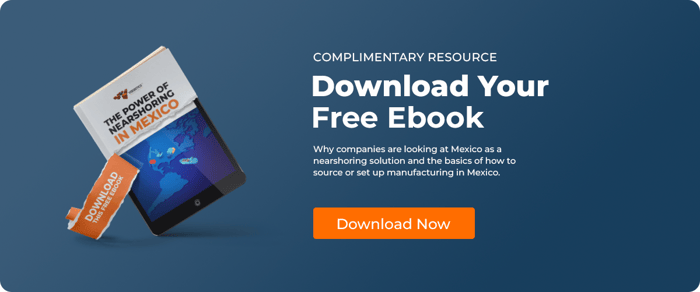Logistics operations involving international trade require a thorough understanding of customs regulations and procedures. When it comes to importing and exporting goods in Mexico, compliance with Mexican customs rules is critical.
In this article, we will look into the intricacies of Mexican customs, exploring the importance of compliance, essential documentation such as Pedimento and Form 7525-v, and the role of the Importer of Record (IOR). By understanding these key aspects, businesses can navigate Mexican customs with confidence, ensuring smooth logistics operations and avoiding costly delays or penalties.
Understanding Mexican Customs
Mexican customs is responsible for regulating and overseeing international trade activities within the country. It plays a crucial role in enforcing customs rules, collecting duties and taxes, and safeguarding the integrity of Mexico's borders. Compliance with Mexican customs rules is essential for businesses engaged in cross-border trade to ensure efficient clearance of goods and adherence to legal requirements.
Common Duties, Taxes, and Fees During Importation
When bringing goods into Mexico, importers must be prepared to pay a range of duties, taxes, and related fees as part of the customs process. These charges can vary depending on the type of goods and their declared value, but generally include:
- Import Duties: Calculated based on the classification and value of the goods, according to Mexico’s Harmonized Tariff Schedule. The rate can differ by product type, port of entry, and country of origin.
- Value Added Tax (VAT): Applied to most imported goods at a standard rate, typically 16%. Some border regions may qualify for a reduced rate.
- Customs Processing Fees: These cover the administrative costs of processing shipments through customs.
- Other Applicable Taxes: Depending on the product, additional taxes—such as Excise Tax (IEPS) on alcoholic beverages, tobacco, or fuel—may also apply.
Accurately calculating and paying these duties, taxes, and fees is essential for the timely release of shipments and compliance with Mexican customs regulations. Missteps in this area can cause delays or, in some cases, result in costly penalties.
Import and Export Procedures
Importing or exporting goods in Mexico involves a series of procedures to comply with Mexican customs requirements. These procedures include documentation, declarations, and inspections. To initiate the import or export process, businesses must submit accurate and complete documentation, such as commercial invoices, packing lists, and the required customs forms. Compliance with these requirements is vital to avoid delays or potential penalties.
One important step in the process is ensuring that all inspections—such as Previo en Origen (PEO)—are conducted thoroughly and with close attention to detail. Overlooking small issues like incorrect documentation, misclassifications, or packaging mistakes can quickly turn into bigger problems. If discrepancies are found during customs clearance, this may trigger further inspections or corrections, leading to significant delays. These delays can result in increased storage costs at ports or warehouses, demurrage fees, or, in some cases, the need to return or re-ship the goods, incurring additional transportation costs. In worst-case scenarios, non-compliance could even lead to goods being seized or confiscated.
Beyond financial considerations, incomplete or inaccurate inspections can open the door to legal complications, including penalties or restrictions on future shipments. Delays, damaged goods, or non-compliance with quality standards may also erode customer trust—potentially resulting in lost business or damage to your company’s reputation.
Taking the time to get every detail right from the start is not only a matter of compliance, but a crucial step in maintaining smooth, efficient cross-border logistics and fostering reliable business relationships.
The Role and Legal Requirement of Customs Brokers in Mexico
Navigating Mexican customs isn't a solo sport—enlisting a licensed customs broker (agente aduanal) is required for most commercial imports. The only notable exception is for low-value, personal-use shipments typically sent through couriers, where this step can be skipped. In all other cases, having a customs broker on your side is not just a best practice; it’s the law.
Customs brokers are key players, guiding importers through the maze of paperwork, ensuring the proper classification of goods, and facilitating compliance with all relevant regulations. Mexican customs law—specifically the Ley Aduanera (Customs Law)—mandates that unless an importer has explicit authorization to handle customs processes directly, they must utilize a broker licensed by the Servicio de Administración Tributaria (SAT), Mexico’s tax authority.
Additionally, detailed guidelines can be found in the Reglamento de la Ley Aduanera (Customs Law Regulations) and the standard NOM-177-SCFI-2018, which outline the responsibilities of customs brokers and reinforce the requirement for their involvement in most import transactions. In short, for commercial imports, working with a licensed customs broker is both a legal obligation and a valuable safeguard for ensuring your goods clear the border smoothly.
The Value of Proactive Inspections and Documentation Checks
Before goods depart for Mexico, careful inspection and review of all shipping documents provide a substantial advantage in the customs process. By ensuring that product descriptions, values, and classifications are all accurate and documented correctly, companies set themselves up for quicker customs clearance—often within just a day or two of arrival. This anticipation of potential issues helps shipments flow smoothly, rather than being derailed by costly hold-ups at the border.
Benefits of thorough pre-shipment checks include:
- Minimized Delays: Spotting discrepancies or errors before shipping helps you address them proactively, rather than scrambling for solutions while the goods sit in a port or warehouse.
- Reduced Extra Costs: Preventing administrative oversights means avoiding unexpected storage fees, demurrage, or the even steeper expenses of returning or re-shipping a container.
- Legal and Regulatory Compliance: Accurate documentation helps ensure you meet the strict requirements of Mexican customs, decreasing the risk of legal penalties, fines, or future shipment restrictions.
- Protection of Business Relationships: On-time, compliant deliveries help preserve trust with customers and partners, safeguarding your reputation and the reliability of your supply chain.
Neglecting these inspections, on the other hand, can cascade into major headaches: shipments held up for further review, mounting storage charges, or—in the worst-case scenario—goods being confiscated. Taking the time to get it right the first time is a small investment compared to the potential costs of a border snafu.
Risks of Incomplete Customs Inspections
Failing to conduct thorough customs inspections—particularly during the Previo en Origen (PEO) process—can trigger a variety of costly setbacks for importers and exporters in Mexico.
When even minor discrepancies slip through, such as inaccurate paperwork, misclassified items, or packaging errors, shipments may be flagged for supplementary inspections or corrections at the border. These hold-ups can rapidly escalate, resulting in extended clearance times and exposing businesses to increased storage charges at ports, warehouses, and potentially expensive demurrage fees.
In more severe instances, incomplete inspections can prompt shipments to be returned to the origin, rerouted, or, in rare cases, confiscated altogether. These scenarios not only amplify transportation and logistics costs but also disrupt supply chains and delivery timelines.
Beyond logistics, non-compliance with Mexican import regulations can carry legal consequences. Businesses may be subject to substantial penalties, and repeated infractions might result in stricter controls or even suspension of future import privileges. Delays or compliance failures can also erode customer trust and damage business reputations, leading to lost sales and diminished market credibility.
What Is Previo en Origen (PEO) and How Does It Streamline Customs in Mexico?
To further smooth the path through Mexican customs, many importers turn to Previo en Origen (PEO), or Pre-Customs Clearance Inspection. This process, rooted in Article 42 of Mexican Customs Law, offers a proactive way to accelerate the entire customs clearance timeline.
How PEO Works
PEO involves a comprehensive inspection of goods at their origin—before they enter Mexico. The main components of this process typically include:
- Reviewing shipping documents for accuracy
- Assessing the physical condition of goods
- Overseeing the loading of containers
- Verifying compliance with customs and shipping standards
By taking care of document reviews and ensuring proper loading and compliance upfront, PEO addresses potential issues before shipment. This meticulous approach helps minimize the risk of shipment discrepancies, damage, or non-compliance.
Speeding Up Customs Clearance
Perhaps the biggest advantage of PEO is the speed it brings to customs clearance upon arrival in Mexico. With all checks completed in advance, shipments are primed for swift processing—often cleared within 24-48 hours—dramatically reducing lead times and the chances of unexpected delays, fees, or regulatory holdups.
Importers benefit from:
- Faster access to goods
- Reduced risk of storage fees or demurrage
- Greater certainty throughout the supply chain
In short, PEO turns potential customs hurdles into manageable steps, giving businesses greater peace of mind and more predictable logistics outcomes.
Container Loading Supervision: Enhancing Customs Compliance and Efficiency
Container loading supervision offers a strategic advantage when navigating Mexican customs. By overseeing the loading process, businesses ensure that goods are accurately counted, properly secured, and matched against accompanying documentation. This level of diligence not only reduces the risk of damage or theft during transit but also helps prevent discrepancies that can trigger customs inspections or delays.
Proper supervision safeguards against errors in packing or labeling, which are common reasons for compliance issues at the border. With all cargo clearly documented and loaded according to regulations, importers and exporters present a strong case for smooth customs clearance. Ultimately, container loading supervision streamlines the process, keeps shipments on schedule, and supports uninterrupted trade operations.
Key Elements of a Previo en Origen Inspection
One vital part of streamlining customs clearance in Mexico is the Previo en Origen process—a pre-customs inspection conducted before goods ever reach Mexican territory. This step, grounded in Article 42 of the Mexican Customs Law, helps ensure that shipments are properly classified and fully compliant with customs regulations, heading off surprises down the line.
The main components of a Previo en Origen inspection include:
- Review of Documentation: Inspectors assess all shipping and customs documents—including commercial invoices and packing lists—to verify accuracy and consistency with the physical shipment.
- Product Condition Checks: The goods themselves are examined to confirm their state, quantity, and conformity with declared descriptions.
- Supervision of Container Loading: The inspection team observes the loading process to ensure goods are packed as declared, which helps prevent discrepancies during customs clearance.
- Verification of Compliance: Inspectors evaluate whether shipments meet regulatory requirements, from labeling to product standards, minimizing risks of delays or penalties at the border.
By conducting these checks before arrival in Mexico, businesses can catch and correct issues early—helping shipments clear customs more smoothly and avoiding the sort of last-minute headaches that can disrupt supply chains.
Essential Documentation: The Role of Pedimento and Form 7525-v:
Two crucial documents in Mexican customs procedures are the Pedimento and Form 7525-v. The Pedimento is a comprehensive customs declaration form that provides detailed information about imported or exported goods, their value, origin, and classification. It is a key document for customs clearance and compliance. Form 7525-v, also known as the Shipper's Export Declaration, is required for exports from Mexico and provides essential information about the goods being shipped.
Tariff Classifications: Proper Classification for Customs Compliance
Proper tariff classification is crucial for customs compliance in Mexico. Goods imported or exported must be correctly classified according to the Harmonized System (HS) codes. The HS codes are internationally recognized codes that identify and categorize specific products. Accurate classification ensures the proper assessment of duties and taxes, as well as adherence to any applicable regulations or restrictions.
Importer of Record (IOR): Exploring the Importance and Responsibilities
The Importer of Record (IOR) is a key party in Mexican customs procedures. The IOR is responsible for ensuring compliance with customs rules, including accurate documentation, payment of duties and taxes, and adherence to import regulations. Being the IOR carries significant responsibilities, and businesses must understand the role and obligations associated with it to avoid any compliance issues.
Before you can act as an IOR and import goods into Mexico, registration with the Mexican Registry of Importers (Padrón de Importadores) is generally required. This registry authorizes businesses or individuals to import specific categories of goods into the country. The registration process involves submitting relevant documentation to the Mexican Tax Administration (SAT) to demonstrate eligibility and compliance with applicable regulations. It is important to note that certain products, such as some types of machinery, may be exempt from the Padrón de Importadores requirement, but most commercial goods will require this step.
Understanding these requirements and ensuring timely registration as an importer are essential first steps for businesses looking to navigate Mexican customs successfully. This foundational compliance sets the stage for efficient customs clearance and minimizes the risk of delays or penalties.
Post-Clearance Obligations: Record-Keeping and Customs Audits
After your goods have successfully cleared customs, your responsibilities as an importer in Mexico don't end at the border. Maintaining compliance continues well into the post-clearance phase.
A critical post-clearance obligation is record-keeping. Importers and exporters are required to retain all customs-related documents—including Pedimento forms, commercial invoices, shipping records, and proof of payment of duties and taxes—for at least five years. This documentation must be readily available in case of a review by Mexican customs authorities.
Customs officials may also conduct post-clearance audits or inspections to verify that importers have complied with all relevant regulations. These audits can assess whether the proper duties were paid, HS classifications were correct, and if the importer adhered to trade restrictions or licensing requirements. Failing to maintain proper records or comply during an audit can result in fines or additional penalties.
By staying diligent with your documentation and being prepared for potential audits, businesses can ensure ongoing compliance and avoid disruptions to their cross-border operations.
How efficient are customs processes for imports and exports in Mexico?
The efficiency of customs processes for imports and exports in Mexico can be attributed to various factors. One key aspect is the notable improvement in customs procedures over the years, propelled by initiatives such as NAFTA and now the USMCA. These agreements have led to the establishment of an expedited processing system, facilitating smooth logistics and ensuring quick turnaround times for shipments back to the United States.
Mexico boasts an extensive network of customs infrastructure, comprising 49 major customs offices strategically located across the country. These offices are evenly distributed, with 21 situated at the borders, 17 dedicated to maritime operations, and 11 serving as interior customs offices. Additionally, Mexico is equipped with 66 border crossings, with 57 located on the northern border and 8 on the southern border.
The substantial volume of trade between Mexico and the United States is another contributing factor to the efficiency of customs processes. As approximately 85% of Mexico's exports are destined for the U.S., there is a vested interest among Mexican customs houses, logistics companies, and transportation providers in ensuring swift and hassle-free transportation, as well as compliance with import and export regulations.
To put the magnitude of trade into perspective, more than 10.7 million cargo trucks cross the northern border annually, underscoring the need for streamlined customs procedures and effective collaboration between customs brokers, logistics firms, and relevant stakeholders. In this regard, companies like CPI actively work with these partners to ensure efficient transportation back to the United States and compliance with import-export requirements. Their Shelter IMMEX Program is designed to provide clients with seamless operations in both Mexico and the U.S., further enhancing the overall efficiency of customs processes.
In conclusion, the customs processes for imports and exports in Mexico exhibit notable efficiency, driven by factors such as favorable trade agreements, well-distributed customs infrastructure, and a large volume of trade with the United States. These elements collectively contribute to streamlined logistics, quick turnarounds, and compliance in cross-border operations.
How Long Does the Mexican Customs Process Take?
While these factors collectively foster an environment of efficiency, the actual duration of the Mexican customs process can vary. Processing times depend on several variables, including port saturation, the complexity of the shipment, the accuracy and completeness of the documentation, and whether any inspections or additional checks are required. In general, customs clearance can take anywhere from a few days to several weeks.
Electronic submission of documents and timely payment of duties and fees can help expedite procedures. However, it's important to note that unforeseen delays may occur, particularly in cases where documentation issues arise or when a shipment is selected for detailed inspection. Leveraging Previo en Origen (PEO) services, which allow for pre-inspection of goods before arrival at the border, can further streamline the process and help avoid bureaucratic slowdowns.
In conclusion, the customs processes for imports and exports in Mexico exhibit notable efficiency, driven by factors such as favorable trade agreements, well-distributed customs infrastructure, and a large volume of trade with the United States. These elements, combined with careful preparation and proactive use of available services, contribute to streamlined logistics, quick turnarounds, and robust compliance in cross-border operations.
Recent Trends: Mexico’s Merchandise Imports by Category and Country
Mexico’s import landscape continues to show dynamic growth, reflecting the country’s vital role in global trade networks. In 2024, total merchandise imports climbed to approximately $625 billion, marking a 4.5% uptick compared to the previous year.
When we break down imports by product category, the majority of goods brought into Mexico fall into three main groups:
- Consumer Goods: Imports in this category rose by 3.6% in 2024, reaching just over $90 billion. These include products destined for direct consumption, ranging from electronics and clothing to everyday household items.
- Intermediate Goods: By far the largest segment, intermediate goods experienced a 4.4% increase, accounting for close to $473 billion of total imports. These are the essential components, raw materials, and parts that feed Mexico’s robust manufacturing and export sectors.
- Capital Goods: This category, covering machinery and equipment used for production, saw a decline. Imports dropped by 6.3% in the third quarter of 2024, totaling around $15 billion—a notable contraction and the steepest drop since 2020.
Looking at country of origin, the United States remains Mexico’s dominant trading partner, supplying the lion’s share of imported goods. In 2024, U.S. exports to Mexico were valued at approximately $118 billion. Other leading import partners include China ($17.6 billion), Japan ($13 billion), Germany ($8.7 billion), and South Korea ($6.5 billion). This diverse sourcing underscores Mexico’s integration with both regional and global supply chains.
These figures highlight the scale and diversity of Mexico’s import market—and provide valuable context for businesses planning to navigate customs or expand their operations across the border.
Support From a Logistics Consultant
Navigating Mexican customs and ensuring compliance with customs rules is essential for smooth logistics operations and trade activities in Mexico. By understanding the requirements and procedures, businesses can minimize delays, avoid penalties, and maintain efficient supply chain operations. At Visigistics, we specialize in providing logistics consulting and cross-border logistics solutions. Our team of experts can guide and support businesses in navigating Mexican customs, ensuring compliance, and optimizing trade operations. Contact us today to learn more about how we can help your business succeed in its logistics endeavors.
Frequently Asked Questions:
Which transportation documents are required when moving loads by truck from Mexico to the US?
When transporting goods by truck from Mexico to the United States, specific documents are essential to facilitate the process and ensure compliance with cross-border regulations. The necessary paperwork includes:
Bill of Lading (BOL): This is the primary document used in the transportation of goods by truck. It serves as a contract between the shipper and the carrier, detailing the type, quantity, and destination of the goods being carried.
Bill of Lading Supplement: Often accompanying the Bill of Lading, this supplement provides additional details that might not be covered in the main BOL. It's crucial for record-keeping and clarifying any special instructions or conditions pertaining to the shipment.
These documents must be accurate and consistent with other shipment records such as the invoice and packing list to ensure a smooth customs clearance and transportation process.
What is the purpose of a packing list in the export process from Mexico to the US?
In the export process from Mexico to the US, a packing list serves as essential documentation required for compliance with Mexican customs rules. It provides detailed information about the contents of the shipment, including the quantity, description, and weight of each item. The packing list plays a crucial role in facilitating customs clearance by ensuring that the goods are accurately accounted for and matched with other required documentation. By including a packing list with the shipment, businesses can streamline the export process, avoid delays, and demonstrate transparency in their trade activities.
Moreover, the packing list must meticulously indicate the contents and type of each box containing the goods. It is imperative that this document matches the invoice precisely, detailing the exact quantity of the pieces in each box and the type of packaging used. This level of detail is vital for ensuring that all items are correctly accounted for during shipping and customs procedures, providing an additional layer of verification that helps prevent discrepancies and potential hold-ups at the border.
By adhering to these stringent requirements, companies engage in a higher standard of accuracy and compliance, reinforcing the integrity of their export operations and facilitating smoother transactions across international borders.
Why is quality certification and merchandise quantification important in the export process?
Understanding why quality certification and merchandise quantification are pivotal in the export process begins with recognizing the critical role they play in maintaining international trade standards. Quality certification is essential because it validates that the products meet specific criteria set by the importing country, covering everything from safety standards to environmental regulations. This assures the importing country and the consumers that the products they receive are safe, reliable, and of high standard.
Merchandise quantification, on the other hand, ensures the accuracy of the amount, weight, and size of the products being shipped. This is crucial for logistical planning, pricing, and compliance with customs regulations. Accurate quantification prevents disputes over shipments and helps in smooth customs clearance, avoiding costly delays.
Together, quality certification and merchandise quantification help in:
Building trust with buyers and maintaining long-term trade relationships.
Ensuring compliance with international legal and regulatory requirements.
Facilitating efficient and faster customs clearance, thus enhancing overall transaction speed.
These factors are integral to successful exports, making quality certification and merchandise quantification indispensable in the global market framework. They not only safeguard the interests of the exporters and consumers but also ensure that the global trade ecosystem remains robust and reliable.
Should exporters from Mexico consider registering before a corresponding chamber, and why?
When considering whether Mexican exporters should register with a corresponding chamber, it’s important to understand the benefits even though there's no mandatory requirement to do so. Joining a chamber can provide several advantages:
- Networking Opportunities: Being part of a chamber facilitates connections with other businesses, potential customers, and suppliers within and beyond Mexico. This can lead to new business opportunities and collaborations.
- Increased Credibility: Registration can enhance a company’s credibility. Businesses often view membership as a sign of reliability and a commitment to good business practices.
- Access to Resources: Chambers often offer resources such as training, market research, and legal advice that can be crucial for navigating both domestic and international markets.
- Advocacy and Support: Chambers represent the interests of their members, providing a stronger voice in discussions and negotiations with governments and regulatory bodies. In conclusion, while registration is not compulsory, the advantages make a compelling case for Mexican exporters to consider joining a chamber. It opens up numerous avenues for growth and support that can significantly benefit business operations.
Why is it important to protect intellectual property rights when exporting from Mexico to the US?
When exporting from Mexico to the U.S., safeguarding intellectual property (IP) rights is paramount. This ensures that unique inventions, designs, and trademarks are legally protected under U.S. IP laws, which differ from those in Mexico. Filing for patents guards inventions, while registering trademarks ensures brand identity is preserved and not misused across borders.
Protecting intellectual property:
Prevents unauthorized use: Ensuring you have the rights in both countries reduces the risk of counterfeit products and other businesses exploiting your innovations.
Maintains competitive advantage: Securing IP rights keeps the competitive edge by ensuring that only the original creator has the right to use, manufacture, or sell the protected work.
Increases business valuation: IPs can significantly increase the value of a business, as they are considered tangible assets that can attract investors or be beneficial in mergers and acquisitions.
Therefore, leading with a comprehensive IP protection strategy when exporting to the U.S. is essential not only for maintaining the integrity of your products and services but also in leveraging your market position and economic value. If you need access to a US-based IP Attorney, contact us as we can refer you to someone.
What is RFC (“Registro Federal de Contribuyentes”) and why is it required for exporters from Mexico to the US?
Understanding RFC: Essential for Exporters from Mexico to the US
The RFC, or Registro Federal de Contribuyentes, is a crucial requirement for individuals or entities engaging in business activities within Mexico. This includes legal situations that necessitate periodic tax declarations or the issuance of tax receipts. Specifically for exporters, the RFC serves as a tax identification number.
Why is the RFC Required?
For businesses in Mexico exporting goods to the US, registration with the RFC is mandatory. This registration ensures that all taxable activities are properly documented and that the businesses are compliant with Mexican tax laws. The RFC facilitates efficient tax collection and regulation, ensuring that exporting entities contribute appropriately to the national revenue. This system also helps in streamlining the process of export documentation, making cross-border business smoother and more compliant with international standards.
By registering with the RFC, exporters not only adhere to local laws but also fortify their operations by ensuring transparency and accountability in financial dealings.
What documents are needed to export from Mexico to the US?
Exporting goods from Mexico to the U.S. requires meticulous documentation to ensure compliance with regulations on both sides of the border. Here's a detailed guide on the essential documents needed to facilitate this process:
Federal Taxpayer Registry (RFC)
Mexican exporters must register in the "Registro Federal de Contribuyentes" or RFC. This applies to all individuals and companies engaging in export activities and necessitates periodic tax declarations and issuing of tax receipts.
Intellectually Property Rights Protection
Exporters dealing with inventions or trademarks need to secure their intellectual property via patent filings and copyright registrations. This step is crucial to protect your innovations and creative works from infringement.
Business Registration
While joining a business chamber is not mandatory, enrollment can provide significant advantages such as advocacy and networking opportunities that could facilitate the export process.
Country of Origin Labeling
Goods must be clearly marked with their country of origin. The markings should adhere to Mexican Standards (NMX) and Mexican Official Standards (NOM) and should comply with the import regulations of the U.S.
Customs Clearance
This process involves a customs broker who represents the exporter in filing the necessary documentation at customs. Documents required include the customs export declaration and proof of payment of any applicable export taxes.
To ensure a smooth customs clearance, exporters must coordinate closely with their customs broker (agente aduanal), as the broker is responsible for submitting all relevant paperwork and ensuring compliance with both Mexican and U.S. regulations. The customs broker assists in preparing the export declaration—pedimento de exportación—which includes key details such as shipment weight, value, description, and destination. Accuracy in this documentation is critical, as errors or omissions can result in significant delays, additional inspections, or even penalties.
In addition to the customs export declaration and tax payment proof, exporters should gather supporting documents such as the commercial invoice (in Spanish), packing list, bill of lading, and any certificates demonstrating compliance with regulatory or quality standards. These documents are submitted electronically through the customs system, accompanied by payment of all duties, taxes, and applicable fees.
Once submitted, customs officials review the documentation for accuracy and completeness. Physical inspections of the goods may be conducted to verify that the shipment matches the details provided. If all requirements are met, the goods are cleared for export. It is crucial to maintain all customs documentation for at least five years, as authorities may conduct post-clearance audits to ensure ongoing compliance.
Export Documentation
Key documents include:
Commercial Invoice: Lists the value and a description of the goods.
Customs Export Application: Needs to be filled out along with an entrustment letter.
Packing List: Details the content, quantity, and packaging of each shipment box.
Quality and Compliance Certification
Before shipment, certain goods might need to undergo inspection for quality assurance and compliance with international standards. Companies may need certificates verifying that goods meet specific standards related to quality, quantity, and safety.
Transport Documentation
For goods transported by truck, documentation such as the Bill of Lading and its supplement are necessary. These documents should correspond with details on the invoice and packing list, ensuring all shipped items are accounted for accurately.
Obtaining and organizing these documents is critical for a smooth and legal export process from Mexico to the U.S. Proper documentation not only ensures compliance with export regulations but can also expedite customs clearance, thus preventing costly delays.
What documents need to be presented along with the customs export application?
When preparing a customs export application, it is imperative to include specific documents to ensure adherence to legal standards and facilitate smooth logistics operations.
Commercial Invoice
First, the commercial invoice or any document that reflects the value of the merchandise must be presented. This is essential as it accompanies the customs declaration, forming the backbone of your export documentation. Additionally, the application should include an “entrustment letter,” which captures vital details such as the data related to the exporting company, the customs broker, date and place of export, type of goods, their value and quantity, customs procedure of export, and the designated customs office of export.
Pedimento and Form 7525-v
Beyond these specific requirements, two critical forms play a pivotal role in Mexican customs procedures: the Pedimento and Form 7525-v. The Pedimento is a comprehensive customs declaration that provides detailed information about the goods, including their value, origin, and classification—a key document for customs clearance and compliance. Meanwhile, Form 7525-v, also known as the Shipper's Export Declaration, is required for exports from Mexico and furnishes essential details about the exported goods.
Understanding these documentation needs is just the beginning. Proper tariff classification is essential for compliance in Mexico. Goods imported or exported must be accurately classified according to the Harmonized System (HS) codes. Furthermore, the Importer of Record (IOR) plays a critical role in ensuring compliance with customs rules. This includes managing accurate documentation, paying duties and taxes, and adhering to import regulations. The responsibilities of being the IOR are significant, and businesses must fully grasp the role and its obligations to avoid any compliance issues.
Key Steps to Navigating Mexican Customs
To move your goods across the Mexican border efficiently, a clear understanding of the customs process is crucial. Here’s what businesses need to know:
Registering as an Importer
Businesses must be registered with the Mexican Registry of Importers (Padrón de Importadores) to legally import goods, unless their products fall under specific exemptions (such as certain machinery). Registration involves submitting the necessary paperwork to Mexico's tax authorities and demonstrating compliance with local regulations.
Accurate Goods Classification
Classification of goods using the correct HS code is not just a technicality—it determines applicable duties, taxes, and regulatory requirements. Accurately classifying your products based on their nature, intended use, and material composition is essential to prevent costly delays, fines, or misapplication of tariffs.
Engaging a Licensed Customs Broker
In most cases, working with a licensed customs broker (agente aduanal) is mandatory for commercial imports. The broker manages all aspects of the import process, from preparing documentation to ensuring compliance with Mexican customs law. Only low-value personal shipments sent by courier might be exempt from this requirement.
Preparing the Import Declaration (Pedimento de Importación)
The Pedimento de Importación is the cornerstone of customs clearance. This official document must be completed with meticulous attention to shipment details: value, origin, destination, weight, volume, and relevant codes. A customs broker’s expertise is invaluable for ensuring accuracy and avoiding compliance issues.
Gathering Required Supporting Documentation
Supporting documents must accompany the Pedimento, including:
- Commercial Invoice (in Spanish): Details the value, description, and sale terms of the goods.
- Bill of Lading: Confirms shipment and transportation specifics.
- Certificate of Origin: Essential if the shipment qualifies for preferential treatment under trade agreements.
- Packing List: Outlines the contents and quantity of each package.
- Compliance Certificates: Proof that goods meet Mexican regulatory and safety standards (such as NOM certification, where required).
Submission and Fees
Once assembled, all documents are submitted electronically to Mexican customs. Duties, taxes (including VAT), and any other applicable fees must be paid before the shipment can be cleared for entry.
Customs Inspection and Clearance
Expect a detailed review of submitted documents, as well as a possible physical inspection of goods to ensure they match the declared information. Inspections may include checks for health, safety, or environmental compliance. Any discrepancies or missing information can result in delays, additional storage costs, or, in worst cases, fines or confiscation of goods.
Post-Clearance Responsibilities
After clearance, businesses should maintain all relevant documentation for at least five years, as customs authorities may conduct audits to ensure ongoing compliance.
By familiarizing yourself with these elements, businesses can navigate Mexican customs with confidence, ensuring smooth logistics operations and avoiding costly delays or penalties. This thorough understanding not only aids in compliance but also streamlines the export process, making it more efficient and less susceptible to errors.







